Analysis of Spatiotemporal Variations and Influencing Factors of Sea Ice Extent in the Arctic and Antarctic
Abstract
:1. Introduction
2. Study Area, Data and Methods
3. Data Analysis
3.1. Analysis of the Features of Seasonal Fluctuations in the Extent of Sea Ice in the Arctic and Antarctic
3.2. Key Years of Sea Ice Extent Changes and Analysis of Future Trends
3.2.1. Analysis of Key Years in Sea Ice Extent Variation
3.2.2. Analysis of Sea Ice Extent Change Trends
3.3. Seasonal Anomaly Analysis of Sea Ice Extent
3.4. Patterns of Sea Ice Extent Changes with Temperature
3.5. Analysis of the Spatiotemporal Distribution Characteristics of Sea Ice Extent
3.5.1. Spatial Overlay Analysis of Multi-Year Sea Ice Extent
3.5.2. Spatial Analysis of the Years in Which the Maximum and Minimum Sea Ice Extents Occurred
3.5.3. Spatial Analysis of the Dynamics of Sea Ice Extent
4. Conclusions
- (1)
- Throughout the study period, Arctic sea ice extent consistently diminished, with 2004 serving as a critical turning point for this decline. Post-2004, a substantial and accelerated decrease was observed. On the other hand, Antarctic sea ice extent initially expanded, then contracted, with significant fluctuations between 2001 and 2014. Following 2014, a marked decline ensued, culminating in 2022 with the lowest recorded sea ice extent of the study period.
- (2)
- In the Arctic, sea ice typically peaks in March and hits its lowest in September. Early in the study, monthly sea ice variations were minimal. But post-2004, significant summer and fall reductions led to greater monthly differences from June to December. In contrast, Antarctic sea ice is at its sparsest in February and most expansive in September. With a seven-month growth season and five-month retreat period, the Antarctic’s ice expansion is slower than its contraction.
- (3)
- Trend analysis suggests that by around 2060, the Arctic’s extensive seasonal ice cover could completely vanish in September. In the Antarctic, sea ice changes in distinct phases, slowly increasing until 2014, and then rapidly declining.
- (4)
- Anomaly analysis reveals that the peak sea ice extent anomaly has progressively moved from September to October in the Arctic, lengthening its melting period. The Antarctic shows greater sea ice extent anomaly fluctuations, with growing anomalies in all seasons. Its interannual stability is decreasing, as evidenced by greater year-to-year variances and a downward growth trend.
- (5)
- The Arctic’s minimum sea ice extent lags nearly two months behind peak temperatures, rapidly responding to temperature shifts. Meanwhile, in the Antarctic, maximum sea ice extent trails two months behind the coldest temperatures, and minimum sea ice extent is delayed by a month relative to the warmest temperatures. The Arctic and Antarctic sea ice extents behave differently in response to temperature changes; it is triangular in the Arctic with distinct turning points, and elliptical in the Antarctic, mainly characterized by steady acceleration in sea ice decrease and increase.
- (6)
- The sea ice extent’s center in the Arctic Ocean leans towards the Pacific side year-round. The spatial layout and fluctuations of sea ice are dictated not only by temperature but also significantly by ocean currents, especially the Atlantic Warm Current, which causes the Atlantic side’s annual minimum sea ice extent to occur sooner than the Pacific’s and leads to a higher dynamic index of sea ice extent compared to other regions. Due to geographical factors, the bulk of Antarctica’s summer sea ice is located in West Antarctica, primarily in the Weddell Sea. The combined effect of topography and cyclones results in less sea ice extent year-round on the western side of the Antarctic Peninsula, which also exhibits the highest sea ice extent dynamic index.
5. Outlook and Discussion
Author Contributions
Funding
Data Availability Statement
Acknowledgments
Conflicts of Interest
References
- Meier, W.N.; Hovelsrud, G.K.; van Oort, B.E.; Key, J.R.; Kovacs, K.M.; Michel, C.; Haas, C.; Granskog, M.A.; Gerland, S.; Perovich, D.K.; et al. Arctic sea ice in transformation: A review of recent observed changes and impacts on biology and human activity. Rev. Geophys. 2014, 52, 185–217. [Google Scholar] [CrossRef]
- Walsh, J.E. Melting ice: What is happening to Arctic sea ice, and what does it mean for us? Oceanography 2013, 26, 171–181. [Google Scholar] [CrossRef]
- Cohen, J.; Agel, L.; Barlow, M.; Garfinkel, C.I.; White, I. Linking Arctic variability and change with extreme winter weather in the United States. Science 2021, 373, 1116–1121. [Google Scholar] [CrossRef] [PubMed]
- Luo, D.; Chen, X.; Overland, J.; Simmonds, I.; Wu, Y.; Zhang, P. Weakened Potential Vorticity Barrier Linked to Recent Winter Arctic Sea Ice Loss and Midlatitude Cold Extremes. J. Clim. 2019, 32, 4235–4261. [Google Scholar] [CrossRef]
- Rind, D.; Healy, R.; Parkinson, C.; Martinson, D. The Role of Sea Ice in 2×CO2 Climate Model Sensitivity. Part I: The Total Influence of Sea Ice Thickness and Extent. J. Clim. 1995, 8, 449–463. [Google Scholar] [CrossRef]
- Vihma, T. Effects of Arctic sea ice decline on weather and climate: A review. Surv. Geophys. 2014, 35, 1175–1214. [Google Scholar] [CrossRef]
- Parkinson, C.L.; DiGirolamo, N.E. New visualizations highlight new information on the contrasting Arctic and Antarctic sea-ice trends since the late 1970s. Remote Sens. Environ. 2016, 183, 198–204. [Google Scholar] [CrossRef]
- Yang, J.; Xiao, C.; Liu, J.; Li, S.; Qin, D. Variability of Antarctic sea ice extent over the past 200 years. Sci. Bull. 2021, 66, 2394–2404. [Google Scholar] [CrossRef]
- Zhao, X.; Xu, L.; Stein, A.; Pang, X. The impact of averaging methods on the trend analysis of the Antarctic sea ice extent and perimeter. Spat. Stat. 2016, 18, 221–233. [Google Scholar] [CrossRef]
- Zwally, H.J.; Comiso, J.C.; Parkinson, C.L.; Cavalieri, D.J.; Gloersen, P. Variability of Antarctic sea ice 1979–1998. J. Geophys. Res. Ocean. 2002, 107, 9-1–9-19. [Google Scholar] [CrossRef]
- Crosta, X.; Etourneau, J.; Orme, L.C.; Dalaiden, Q.; Campagne, P.; Swingedouw, D.; Goosse, H.; Masse, G.; Miettinen, A.; McKay, R.M.; et al. Multi-decadal trends in Antarctic sea-ice extent driven by ENSO-SAM over the last 2000 years. Nat. Geosci. 2021, 14, 156–160. [Google Scholar] [CrossRef]
- Eayrs, C.; Li, X.; Raphael, M.N.; Holland, D.M. Rapid decline in Antarctic sea ice in recent years hints at future change. Nat. Geosci. 2021, 14, 460–464. [Google Scholar] [CrossRef]
- Hobbs, W.R.; Massom, R.; Stammerjohn, S.; Reid, P.; Williams, G.; Meier, W. A review of recent changes in Southern Ocean sea ice, their drivers and forcings. Glob. Planet. Chang. 2016, 143, 228–250. [Google Scholar] [CrossRef]
- Meehl, G.A.; Arblaster, J.M.; Bitz, C.M.; Chung, C.T.Y.; Teng, H. Antarctic sea-ice expansion between 2000 and 2014 driven by tropical Pacific decadal climate variability. Nat. Geosci. 2016, 9, 590–595. [Google Scholar] [CrossRef]
- Sigmond, M.; Fyfe, J.C. Has the ozone hole contributed to increased Antarctic sea ice extent? Geophys. Res. Lett. 2010, 37, L18502. [Google Scholar] [CrossRef]
- Stammerjohn, S.E.; Martinson, D.G.; Smith, R.C.; Yuan, X.; Rind, D. Trends in Antarctic annual sea ice retreat and advance and their relation to El Niño–Southern Oscillation and Southern Annular Mode variability. J. Geophys. Res. 2008, 113, C03S90. [Google Scholar] [CrossRef]
- Wang, Z.; Turner, J.; Wu, Y.; Liu, C. Rapid Decline of Total Antarctic Sea Ice Extent during 2014–16 Controlled by Wind-Driven Sea Ice Drift. J. Clim. 2019, 32, 5381–5395. [Google Scholar] [CrossRef]
- Wang, G.; Hendon, H.H.; Arblaster, J.M.; Lim, E.-P.; Abhik, S.; van Rensch, P. Compounding tropical and stratospheric forcing of the record low Antarctic sea-ice in 2016. Nat. Commun. 2019, 10, 13. [Google Scholar] [CrossRef]
- Parkinson, C.L.; DiGirolamo, N.E. Sea ice extents continue to set new records: Arctic, Antarctic, and global results. Remote Sens. Environ. 2021, 267, 112753. [Google Scholar] [CrossRef]
- Cavalieri, D.J.; Parkinson, C.L. Arctic sea ice variability and trends, 1979–2010. Cryosphere 2012, 6, 881–889. [Google Scholar] [CrossRef]
- Comiso, J.C.; Parkinson, C.L.; Gersten, R.; Stock, L. Accelerated decline in the Arctic sea ice cover. Geophys. Res. Lett. 2008, 35, L01703. [Google Scholar] [CrossRef]
- Haas, C.; Pfaffling, A.; Hendricks, S.; Rabenstein, L.; Etienne, J.L.; Rigor, I. Reduced ice thickness in arctic transpolar drift favors rapid ice retreat. Geophys. Res. Lett. 2008, 35, L17501. [Google Scholar] [CrossRef]
- Nghiem, S.V.; Rigor, I.G.; Perovich, D.K.; Clemente-Colón, P.; Weatherly, J.W.; Neumann, G. Rapid reduction of Arctic perennialsea ice. Geophys. Res. Lett. 2007, 34, L19504. [Google Scholar] [CrossRef]
- Lei, R.B.; Xie, H.J.; Wang, J.; Leppäranta, M.; Jónsdottir, I.; Zhang, Z.H. Changes in sea ice conditions along the arctic northeast passage from 1979 to 2012. Cold Reg. Sci. Technol. 2015, 119, 132–144. [Google Scholar] [CrossRef]
- Xie, H.; Lei, R.; Ke, C.; Wang, H.; Li, Z.; Zhao, J.; Ackley, S.F. Summer sea ice characteristics and morphology in the Pacific Arctic sector as observed during the CHINARE 2010 cruise. Cryosphere 2013, 7, 1057–1072. [Google Scholar] [CrossRef]
- Rodrigues, J. The rapid decline of the sea ice in the Russian Arctic. Cold Reg. Sci. Technol. 2008, 54, 124–142. [Google Scholar] [CrossRef]
- Markus, T.; Stroeve, J.C.; Miller, J. Recent changes in Arctic sea ice melt onset, freeze up, and melt season length. J. Geophys. Res. 2009, 114, C12024. [Google Scholar] [CrossRef]
- Stroeve, J.C.; Kattsov, V.; Barrett, A.; Serreze, M.; Pavlova, T.; Holland, M.; Meier, W.N. Trends in Arctic sea ice extent from CMIP5, CMIP3 and observations. Geophys. Res. Lett. 2012, 39, L16502. [Google Scholar] [CrossRef]
- Overland, J.E.; Wang, M. When will the summer Arctic be nearly sea ice free? Geophys. Res. Lett. 2013, 40, 2097–2101. [Google Scholar] [CrossRef]
- Screen, J.A. Far-flung effects of Arctic warming. Nat. Geosci. 2017, 10, 253–254. [Google Scholar] [CrossRef]
- Sévellec, F.; Fedorov, A.V.; Liu, W. Arctic sea-ice decline weakens the Atlantic meridional overturning circulation. Nat. Clim. Change 2017, 7, 604–610. [Google Scholar] [CrossRef]
- Strawa, A.W.; Latshaw, G.; Farkas, S.; Russell, P.; Zornetzer, S. Arctic ice loss threatens national security: A path forward. Orbis 2020, 64, 622–636. [Google Scholar] [CrossRef] [PubMed]
- Rahmstorf, S.; Box, J.E.; Feulner, G.; Mann, M.E.; Robinson, A.; Rutherford, S.; Schaffernicht, E.J. Exceptional twentieth-century slowdown in Atlantic Ocean overturning circulation. Nat. Clim. Chang. 2015, 5, 475–480. [Google Scholar] [CrossRef]
- Grosfeld, K.; Treffeisen, R.; Asseng, J.; Bartsch, A.; Bräuer, B.; Fritzsch, B.; Gerdes, R.; Hendricks, S.; Hiller, W.; Heygster, G.; et al. Online sea-ice knowledge and data platform. Polarforsch. Bremerhav. Alfred Wegener Inst. Polar Mar. Res. Ger. Soc. Polar Res. 2016, 85, 143–155. [Google Scholar]
- Liu, Z. Arctic sea ice decline and its driving mechanisms. Chin. J. Nat. 2022, 44, 39–46. [Google Scholar]
- Liu, Y.; Wang, Z.; Liu, T. Change Analysis for Antarctic and Arctic Sea Ice Concentration and Extent. Remote Sens. Inf. 2016, 31, 24–29. [Google Scholar]
- Wei, L.; Zhang, Z. Analysis of Arctic Sea Ice Variability. Mar. Forecast. 2007, 24, 42–48. [Google Scholar]
- Yang, J.; He, J.; Zhao, G. Telecorrelation of Arctic Sea-Ice with Spring Sandstorm in Ningxia. J. Nanjing Inst. Meteorol. 2003, 26, 296–307. [Google Scholar]
- Wang, L.; Yang, W.; Zhang, L.; Li, C.; Zhang, F. Effect of Arctic sea ice on precipitation in the main flood season of the Yangtze River basin. Adv. Water Sci. 2019, 30, 623–631. [Google Scholar]
- Zhang, R.; Sun, C.; Li, W. Relationship between the interannual variations of Arctic sea ice and summer Eurasian teleconnection and associated influence on summer precipitation over China. Chin. J. Geophys. 2018, 61, 91–105. [Google Scholar]
- Spreen, G.; Kaleschke, L.; Heygster, G. Sea ice remote sensing using AMSR-E 89 GHz channels. J. Geophys. Res. 2008, 113, C02S03. [Google Scholar] [CrossRef]
- Parkinson, C.L. A 40-y record reveals gradual Antarctic sea ice increases followed by decreases at rates far exceeding the rates seen in the Arctic. Proc. Natl. Acad. Sci. USA 2019, 116, 14414–14423. [Google Scholar] [CrossRef] [PubMed]
- Simmonds, I. Comparing and contrasting the behaviour of Arctic and Antarctic sea ice over the 35 year period 1979–2013. Ann. Glaciol. 2015, 56, 18–28. [Google Scholar] [CrossRef]
- Turner, J.; Hosking, J.S.; Bracegirdle, T.J.; Marshall, G.J.; Phillips, T. Recent changes in Antarctic Sea Ice. Philos. Trans. R. Soc. A: Math. Phys. Eng. Sci. 2015, 373, 20140163. [Google Scholar] [CrossRef] [PubMed]
- Stroeve, J.C.; Serreze, M.C.; Holland, M.M.; Kay, J.E.; Malanik, J.; Barrett, A.P. The Arctic’s rapidly shrinking sea ice cover: A research synthesis. Clim. Chang. 2012, 110, 1005–1027. [Google Scholar] [CrossRef]
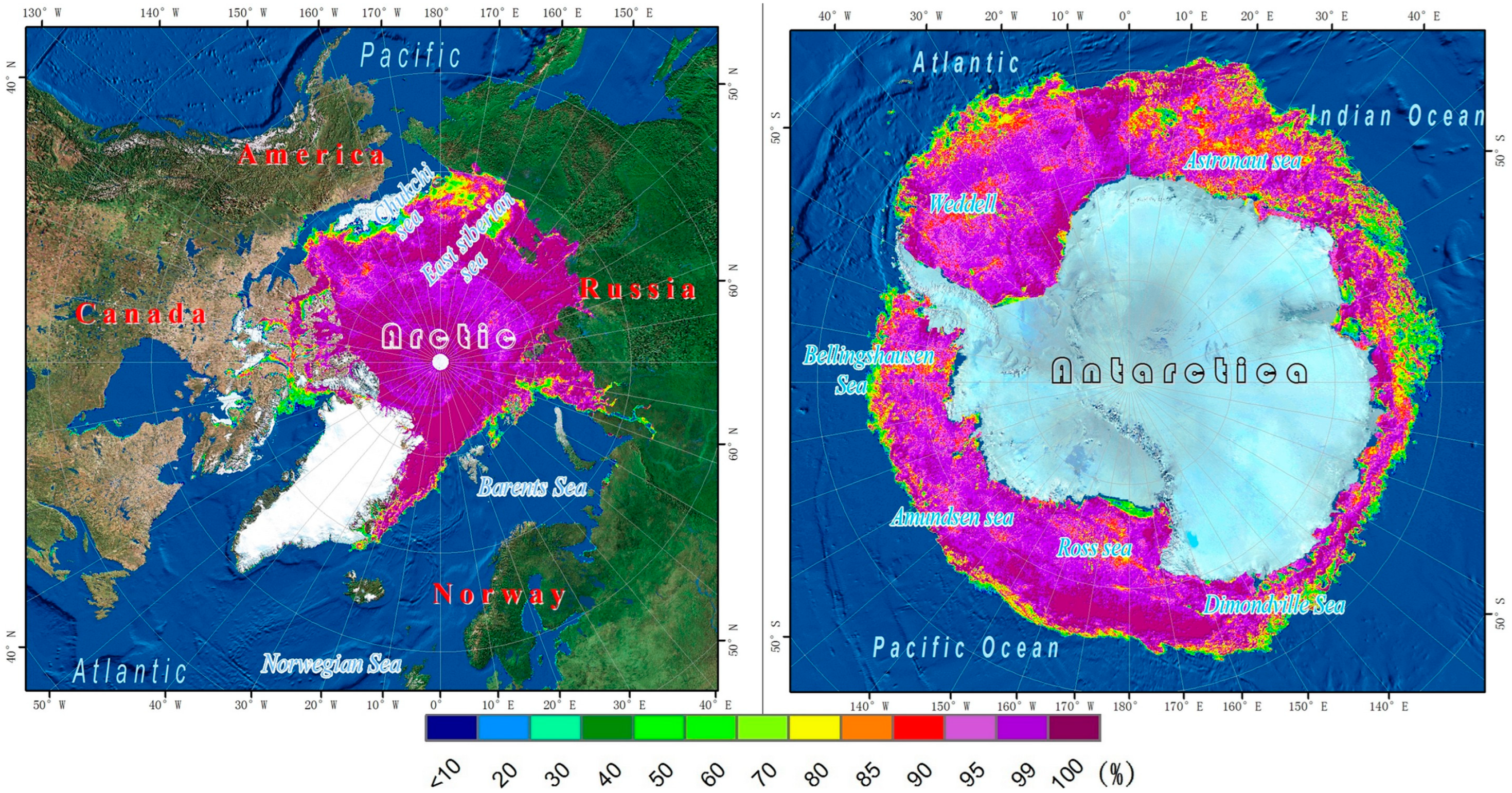


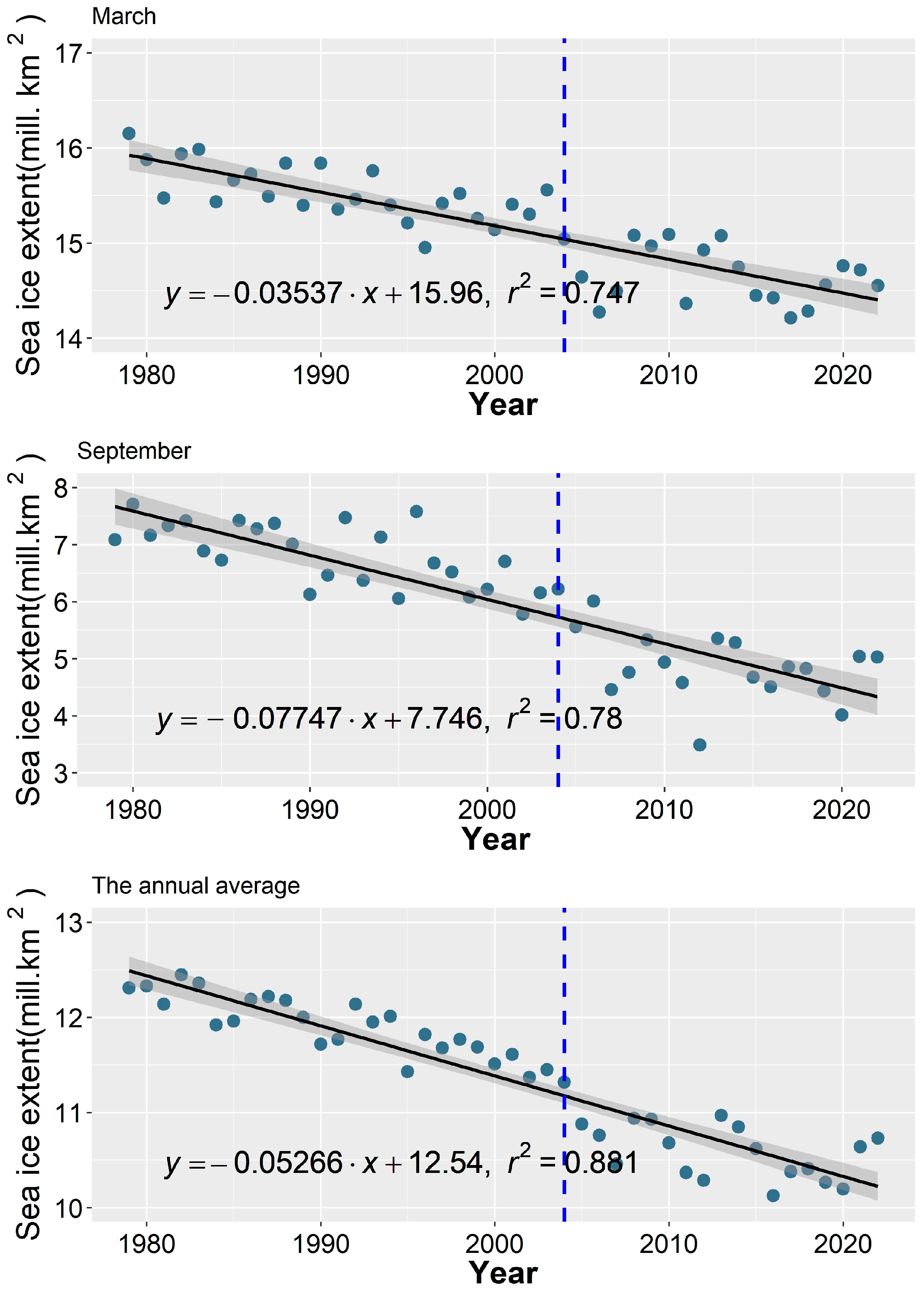
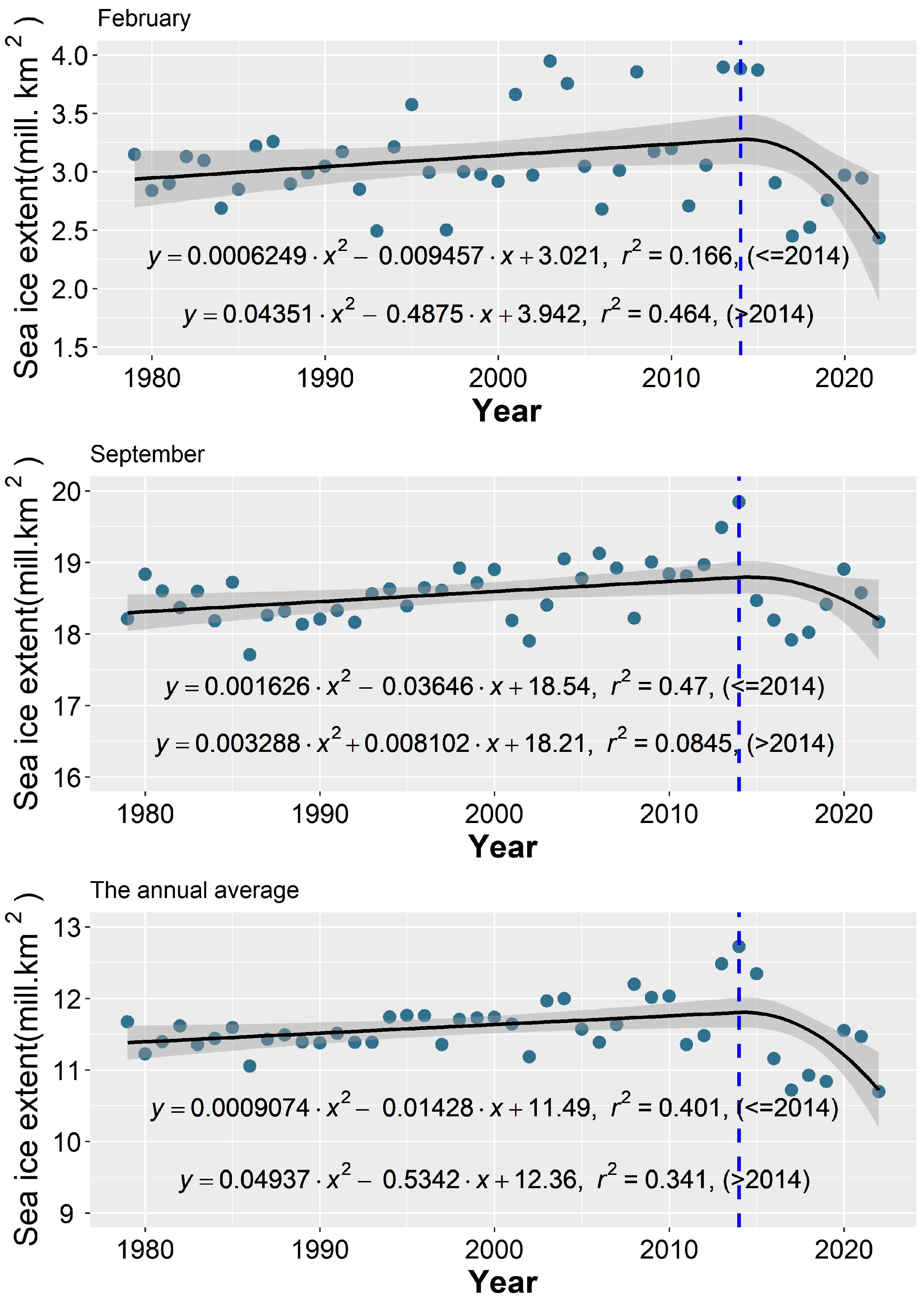
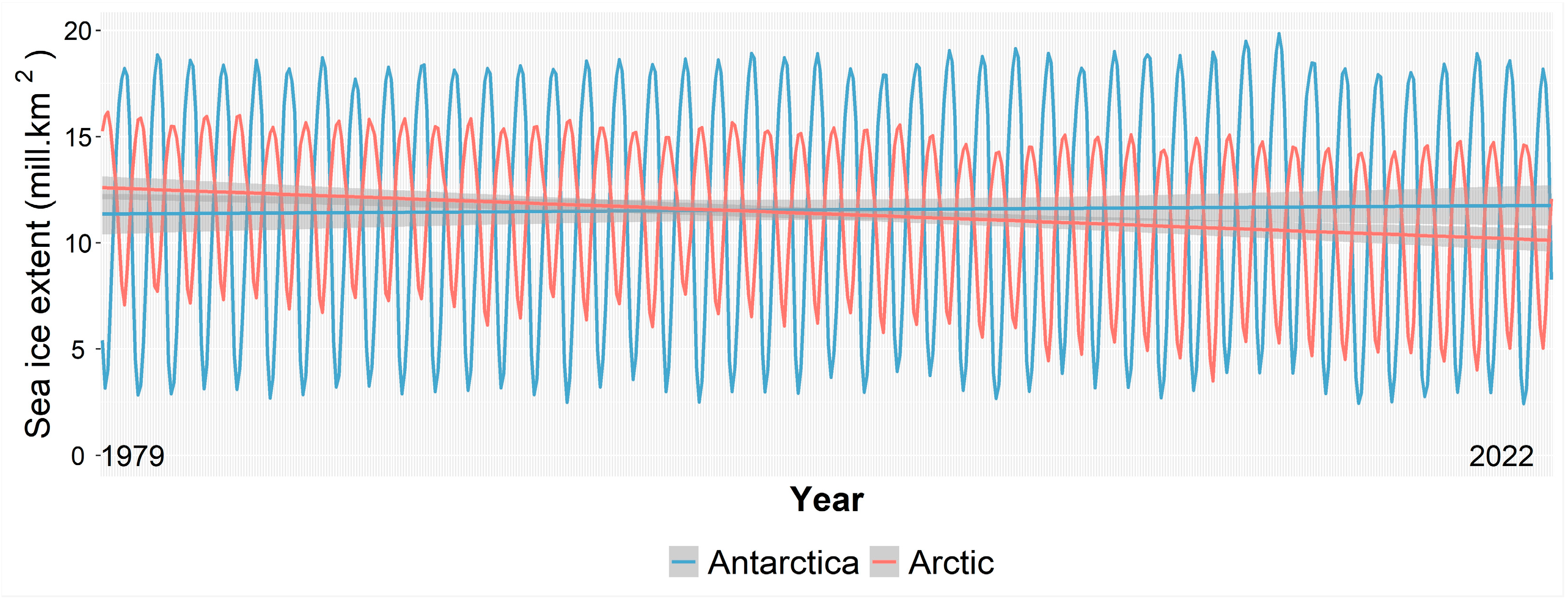
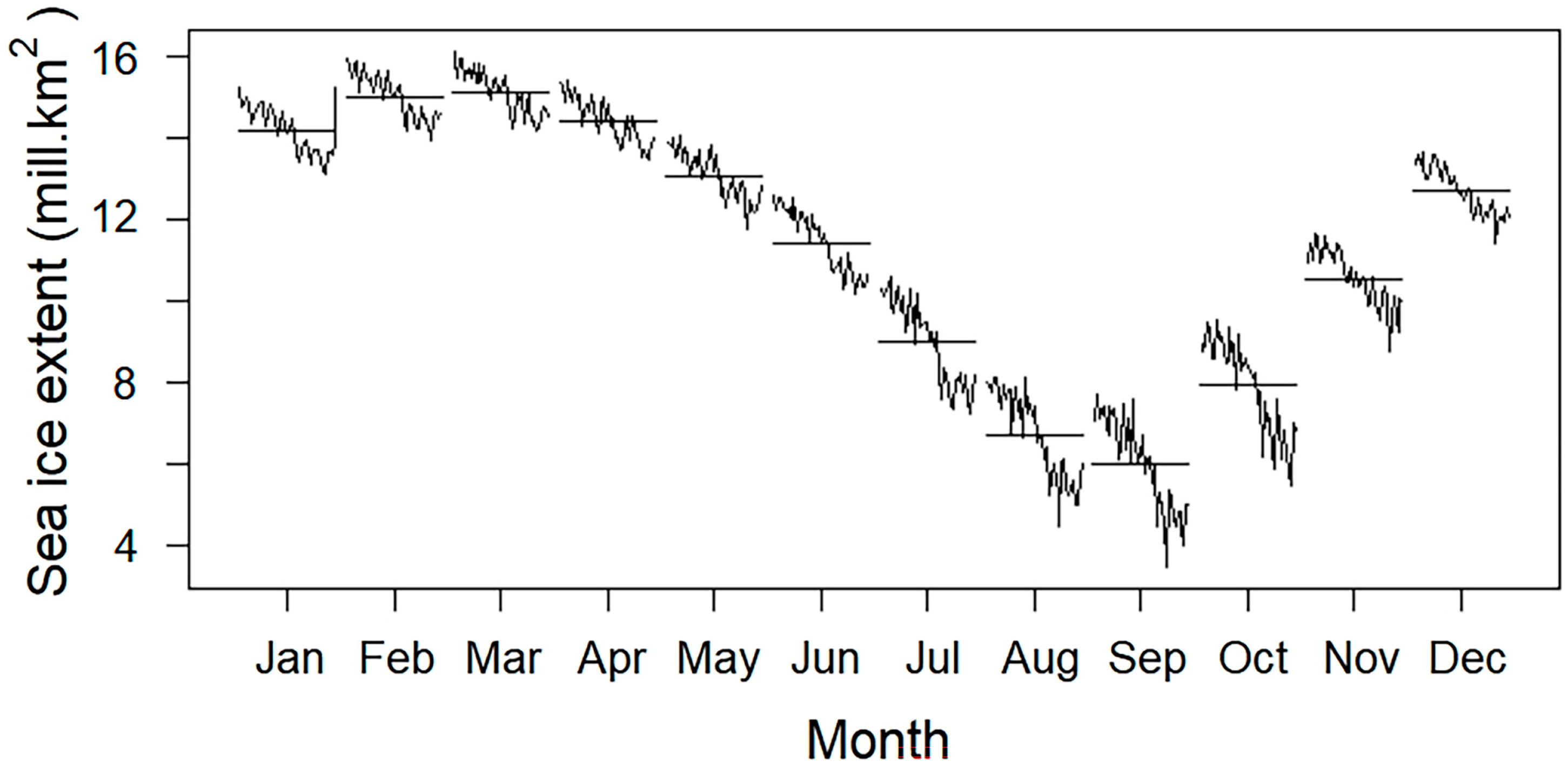
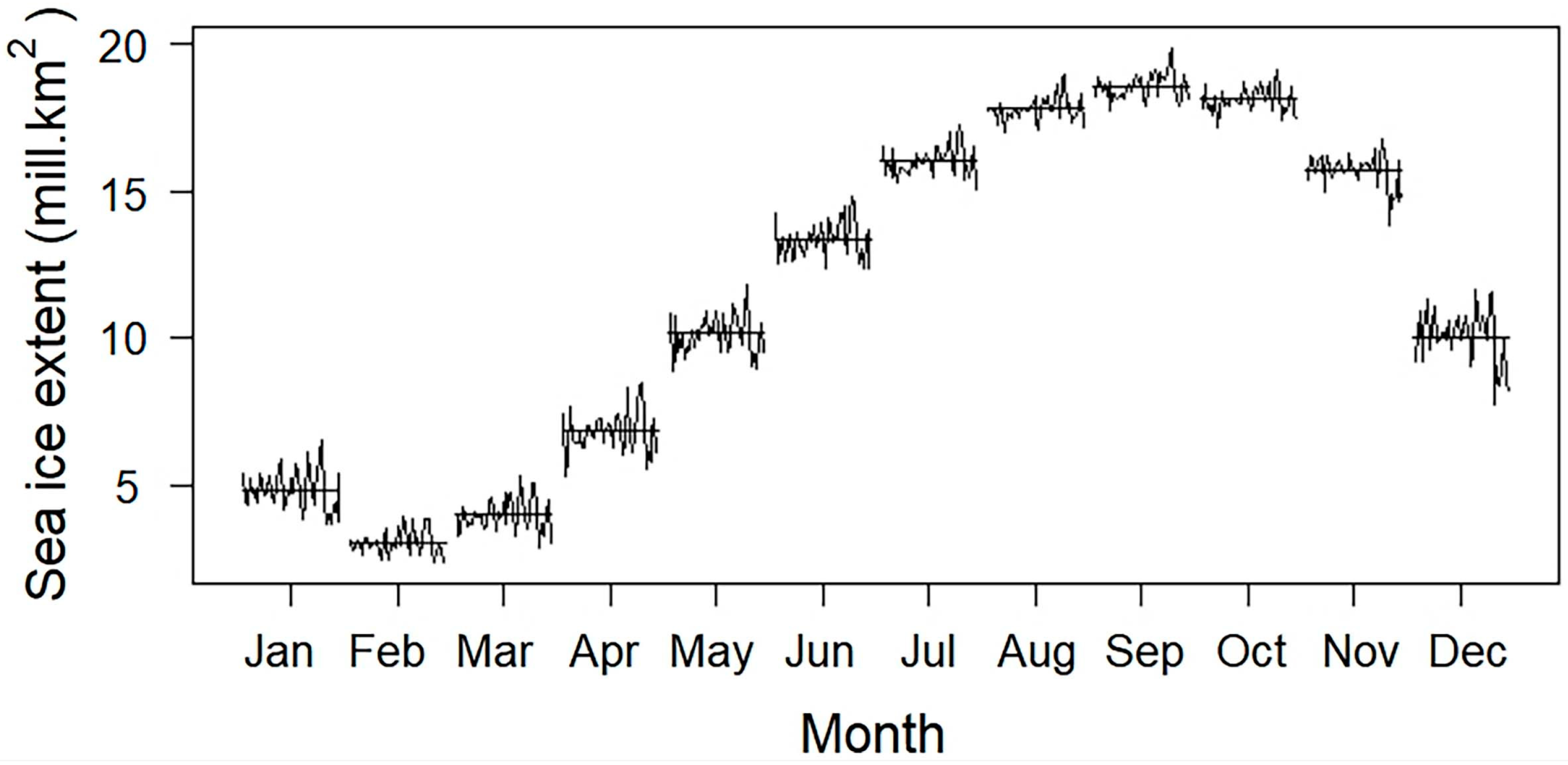
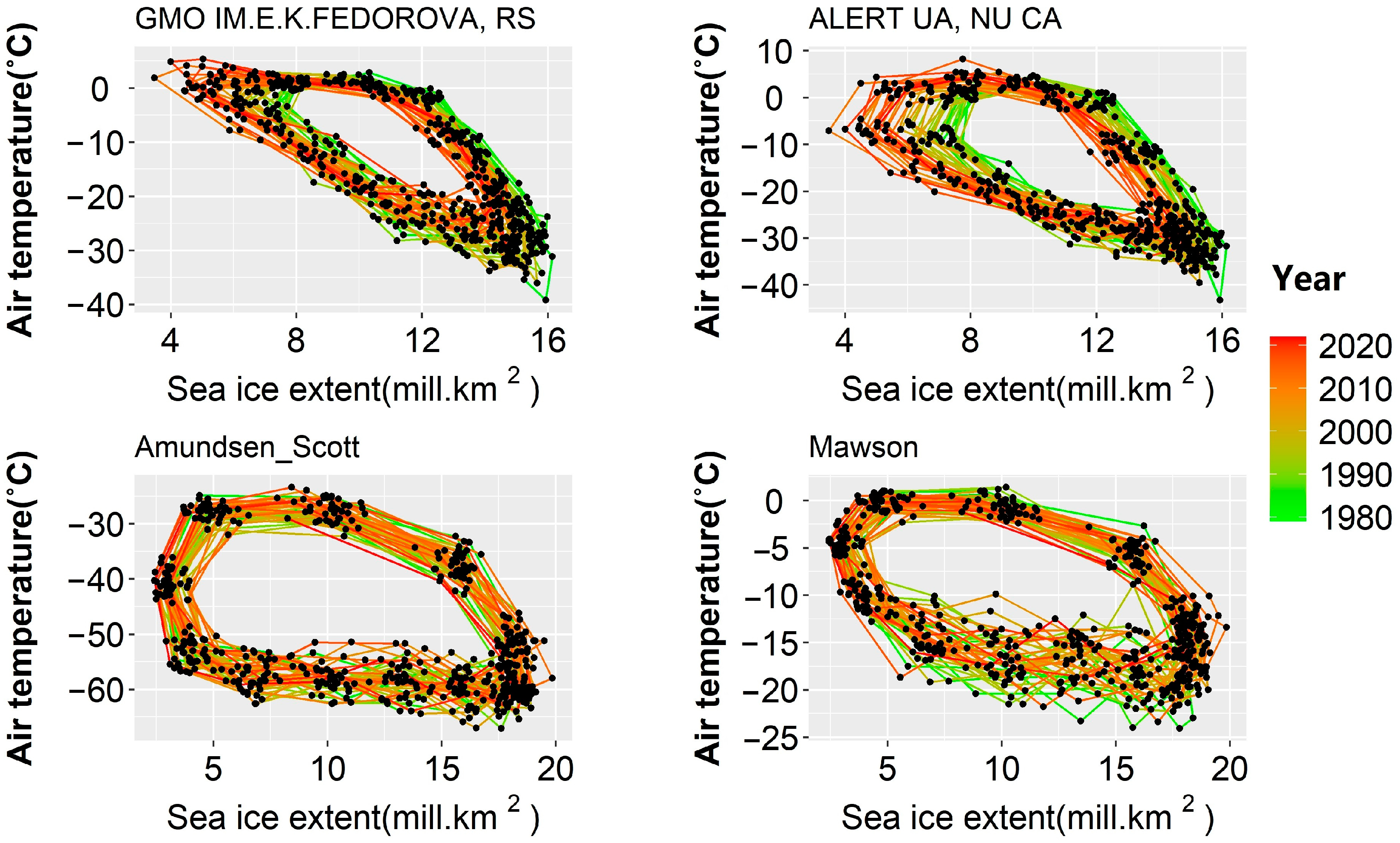
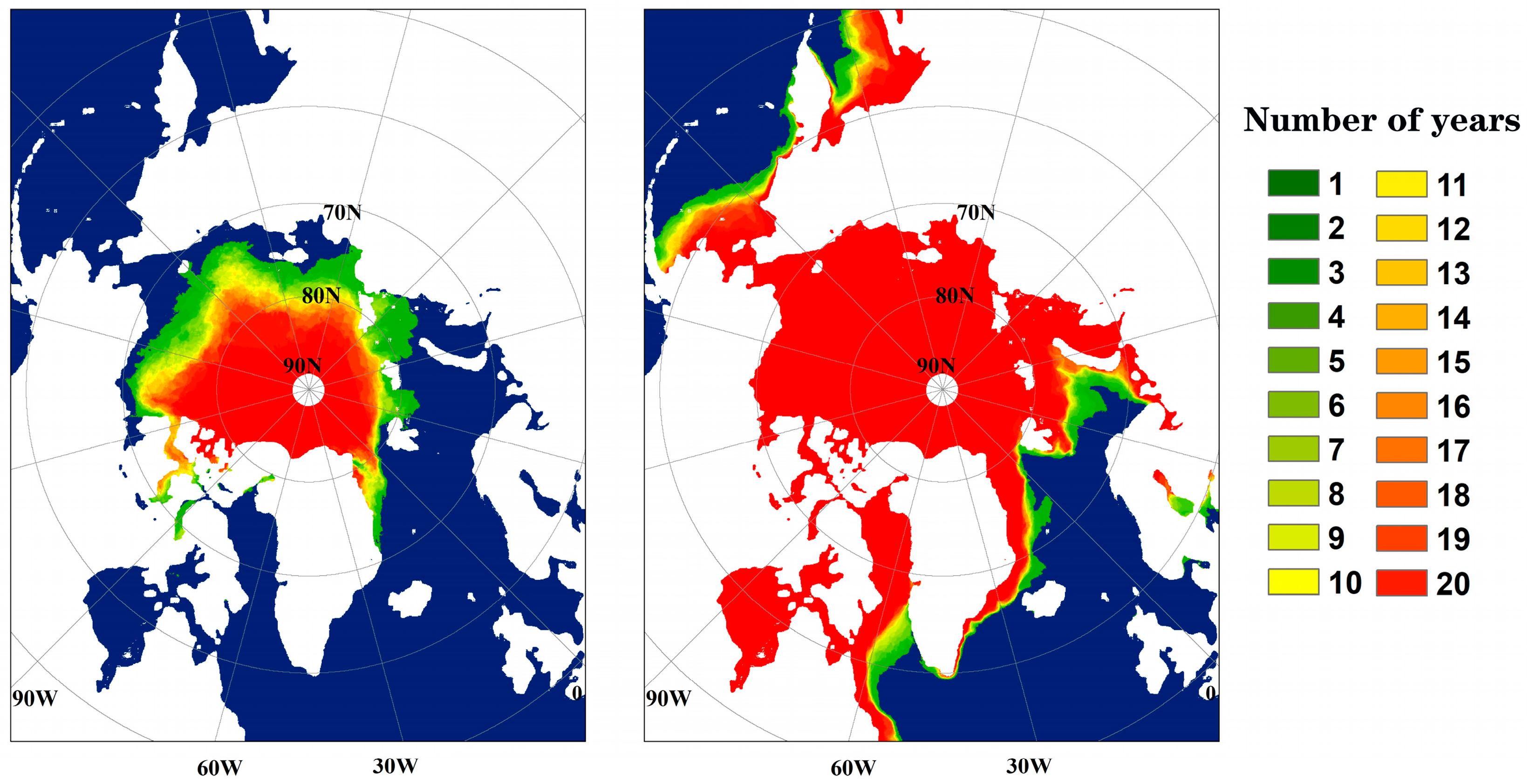
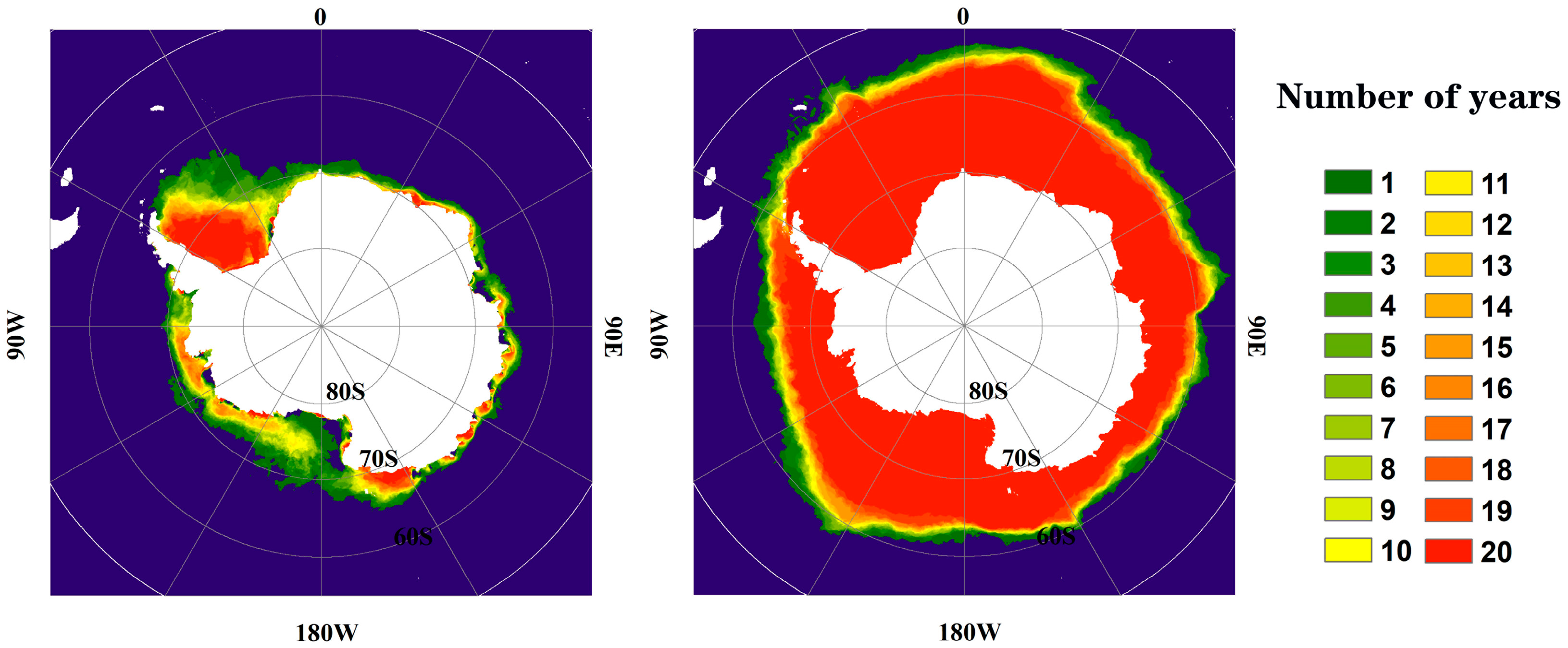



| Year | Satellites and Sensors | Algorithm |
|---|---|---|
| 1972–2002 | NIMBUS-7 SMMR and DMSP SSM/I, 19 and 37 GHz | NASA Team |
| 26 October 1978–October 2010 | NIMBUS-7 SMMR and DMSP SSM/I-SSMIS, 19 and 37 GHz | NASA Team |
| 1 June 2002–4 October 2011 | Aqua AMSR-E, 89 GHz | ASI |
| 5 October 2011–2 July 2012 | F-17 SSMIS, 91 GHz | ASI |
| 3 July 2012–today | GCOM-W1 AMSR2, 89 GHz | ASI |
| Zone Number | Spatial Range | Arctic Sea Ice Extent Dynamics | Antarctic Sea Ice Extent Dynamics |
|---|---|---|---|
| 1 | 0°–60°E | 10.91 | 6.8 |
| 2 | 60°–120°E | 6.21 | 5.57 |
| 3 | 120°–180°E | 4.92 | 7.65 |
| 4 | 180°–240°E | 5.13 | 5.05 |
| 5 | 240°–300°E | 5.67 | 8.63 |
| 6 | 300°–360°E | 6.97 | 5.41 |
Disclaimer/Publisher’s Note: The statements, opinions and data contained in all publications are solely those of the individual author(s) and contributor(s) and not of MDPI and/or the editor(s). MDPI and/or the editor(s) disclaim responsibility for any injury to people or property resulting from any ideas, methods, instructions or products referred to in the content. |
© 2023 by the authors. Licensee MDPI, Basel, Switzerland. This article is an open access article distributed under the terms and conditions of the Creative Commons Attribution (CC BY) license (https://creativecommons.org/licenses/by/4.0/).
Share and Cite
Sun, X.; Lv, T.; Sun, Q.; Ding, Z.; Shen, H.; Gao, Y.; He, Y.; Fu, M.; Li, C. Analysis of Spatiotemporal Variations and Influencing Factors of Sea Ice Extent in the Arctic and Antarctic. Remote Sens. 2023, 15, 5563. https://doi.org/10.3390/rs15235563
Sun X, Lv T, Sun Q, Ding Z, Shen H, Gao Y, He Y, Fu M, Li C. Analysis of Spatiotemporal Variations and Influencing Factors of Sea Ice Extent in the Arctic and Antarctic. Remote Sensing. 2023; 15(23):5563. https://doi.org/10.3390/rs15235563
Chicago/Turabian StyleSun, Xiaoyu, Tingting Lv, Qizhen Sun, Zhuoming Ding, Hui Shen, Yi Gao, Yawen He, Min Fu, and Chunhua Li. 2023. "Analysis of Spatiotemporal Variations and Influencing Factors of Sea Ice Extent in the Arctic and Antarctic" Remote Sensing 15, no. 23: 5563. https://doi.org/10.3390/rs15235563
APA StyleSun, X., Lv, T., Sun, Q., Ding, Z., Shen, H., Gao, Y., He, Y., Fu, M., & Li, C. (2023). Analysis of Spatiotemporal Variations and Influencing Factors of Sea Ice Extent in the Arctic and Antarctic. Remote Sensing, 15(23), 5563. https://doi.org/10.3390/rs15235563










